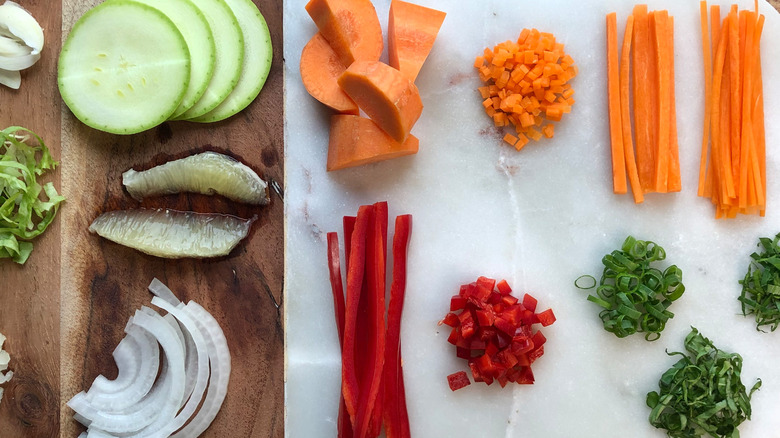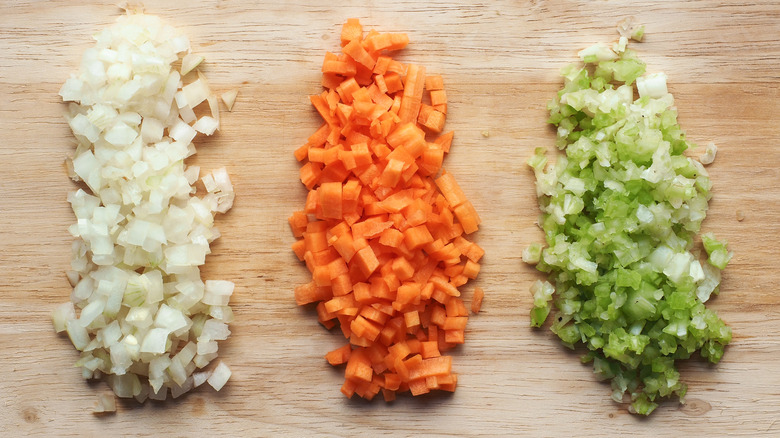The Difference Between Brunoise And Small Dice Knife Cuts
Among home chefs, remembering how to work with the layers of an onion to most efficiently and uniformly chop it means you have pretty good knife skills. The stakes aren't that high — and if you end up with inconsistency among your pieces, you can always gather everything into a pile and run your knife through a few times until the big pieces are sufficiently broken down.
We may not know the difference between dicing and cubing in a recipe, but there are many different cuts a chef must be able to produce with great precision — down to the millimeter, in many cases. Two key vegetable cuts for chefs to master are the small dice, or macédoine cut, and fine dice, or brunoise cut. While both can be described as small cubes, the small dice cut is four millimeters larger than the brunoise — a sizeable difference in professional kitchens — and each is preferable in specific situations. Knife skills are one of the first things taught in culinary school because choosing (and executing) the right cut is essential to ensuring food cooks evenly and each dish that leaves the kitchen is as uniform as possible.
How to cut a brunoise and small dice
While so many individual knife cuts may sound overwhelming, most of them are based on other cuts, pushing established shapes to their furthest possible point. The small dice and brunoise are two examples of that evolution.
To make a small dice, first square off the sides of whatever vegetable you're cutting with a chef's knife, utility knife, or santoku knife — a Japanese-style chef's knife. This eliminates the rounded edges that can make it dangerous and difficult to cut many ingredients while also preventing irregularity in your finished product. Once squared, cut the vegetable into ¼-inch thick, rectangular slices. Then stack your slices and cut them into ¼ inch strips to create the batonnet cut, which is often used for crudité and more slender french fries. Taking the cut one step further, gather batonnets and cut them into ¼ inch cubes — this is your small dice.
To produce an even smaller cube, we have the fine dice or brunoise cut. Again start by squaring off the sides of your ingredient. Then cut it into rectangular slices that are about ⅛ inch thick. Stack your slices and cut them into ⅛ inch thick strips — you've just accomplished the julienne, or matchstick, cut! To complete the cube, cut julienne strips into ⅛ inch pieces. Voila! The brunoise is the smallest dice cut in the culinary world — any smaller is considered minced.
How to choose one over the other
You may impress people with very small, precise cuts — but that doesn't make it better in all situations. The size of your cut is important, and choosing the right one for your ingredient and dish is essential. So which should you use when?
Both cuts can be accomplished with a wide variety of vegetables and aromatics, including carrots, celery, onion, shallot, potatoes, beets, and turnips. For garnishes that bring just the right amount of texture and flavor, use the Brunoise cut. It was actually developed by chefs in Brunoy, France to elevate the visual presentation of dishes at fine dining establishments, so wanting to flaunt your knife skills is perfectly in line with the cut's tradition.
Aromatics you don't want to overpower and vegetables you want to fully incorporate into a sauce or stew also benefit from the smaller brunoise cut. Dishes you want a more prominent vegetable bite in, however, are better suited to the small dice — the cut's French name, macédoine, is also the name of a salad comprised of vegetables cut in this style, highlighting its ideal use. The small dice is also perfect for soups, as it allows vegetables to cook quickly and in similar timeframes.



